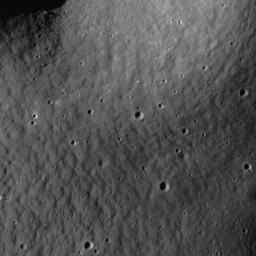
|
Regolith Patterns in Mendel-Rydberg
- Click the image above for a larger view
- Full-Res JPEG (1008 x 1008) (112.8 kB)
- Full-Res TIFF (1008 x 1008) (1.0 MB)
Caption:
Much of the Constellation Mendel-Rydberg region of interest is located in a terrain known as a "cryptomare." Cryptomaria are mare basalt volcanic deposits obscured by superposed materials usually of higher albedo. The obscuring materials are typically the ejecta of later-forming craters and basins, which blanket the older mare basalt. In the case of Mendel-Rydberg, much of the material covering the older mare may have been ejecta from the Orientale basin-forming impact event, which occurred hundreds of kilometers to the north. The fact that the covering ejecta can have varying compositions, thicknesses, and albedos complicates the task of making an inventory of the amounts, composition, and history of lunar volcanism. Consequently, cryptomaria are of high scientific interest (see also the Balmer Basin region ). NAC image M118090761, image width 0.64 km.
Background Info:
NASA's Goddard Space Flight Center built and manages the mission for the Exploration Systems Mission Directorate at NASA Headquarters in Washington. The Lunar Reconnaissance Orbiter Camera was designed to acquire data for landing site certification and to conduct polar illumination studies and global mapping. Operated by Arizona State University, LROC consists of a pair of narrow-angle cameras (NAC) and a single wide-angle camera (WAC). The mission is expected to return over 70 terabytes of image data.
Cataloging Keywords:
| Name | Value | Additional Values |
|---|---|---|
| Target | Moon | |
| System | Earth | |
| Target Type | Satellite | |
| Mission | Lunar Reconnaissance Orbiter (LRO) | |
| Instrument Host | Lunar Reconnaissance Orbiter | |
| Host Type | Orbiter | |
| Instrument | Lunar Reconnaissance Orbiter Camera (NAC) | |
| Detector | Narrow Angle Camera (NAC), Wide Angle Camera (WAC) | |
| Extra Keywords | Crater, Grayscale, Impact, Volcano | |
| Acquisition Date | ||
| Release Date | 2010-05-17 | |
| Date in Caption | ||
| Image Credit | NASA/GSFC/Arizona State University | |
| Source | photojournal.jpl.nasa.gov/catalog/PIA13140 | |
| Identifier | PIA13140 | |
